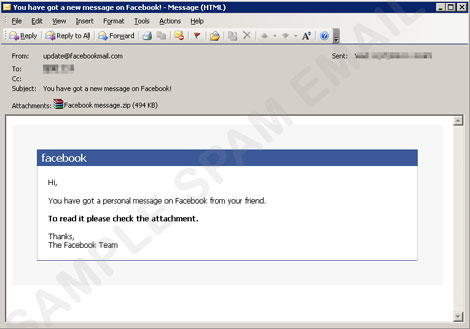WORM_PROLACO.Q
W32.Ackantta@mm; VirTool:Win32/DelfInject.gen!AC; W32/Xirtem@MM; Trojan.Win32.Buzus.gcjo, Mal/Cabbling-A
Windows 2000, XP, Server 2003


Threat Type: Worm
Destructiveness: No
Encrypted: No
In the wild: Yes
OVERVIEW
This worm drops copies of itself in all removable drives. It drops an AUTORUN.INF file to automatically execute the copies it drops when a user accesses the drives of an affected system.
TECHNICAL DETAILS
558,592 bytes
PE
Yes
17 Nov 2010
Installation
This worm drops the following copies of itself into the affected system:
- %System%\Bluetooth.exe
(Note: %System% is the Windows system folder, which is usually C:\Windows\System on Windows 98 and ME, C:\WINNT\System32 on Windows NT and 2000, or C:\Windows\System32 on Windows XP and Server 2003.)
Autostart Technique
This worm adds the following registry entries to enable its automatic execution at every system startup:
HKEY_CURRENT_USER\Software\Microsoft\
Windows\CurrentVersion\Run
BlueTooth HID = %System%\Bluetooth.exe
Other System Modifications
This worm adds the following registry keys:
HKEY_CURRENT_USER\Software\bt1
HKEY_LOCAL_MACHINE\SOFTWARE\bt1
It adds the following registry entries:
HKEY_CURRENT_USER\Software\Microsoft\
Windows\CurrentVersion\Explorer
blue{number} = {number}
HKEY_LOCAL_MACHINE\SOFTWARE\Microsoft\
Windows\CurrentVersion\policies\
system
EnableLUA = 0
HKEY_LOCAL_MACHINE\SYSTEM\CurrentControlSet\
Services\SharedAccess\Parameters\
FirewallPolicy\StandardProfile\AuthorizedApplications\
List
%System%\Bluetooth.exe = %System%\Bluetooth.exe:*:Enabled:Explorer
It modifies the following registry entries:
HKEY_LOCAL_MACHINE\SYSTEM\CurrentControlSet\
Services\ERSvc
Start = 4
(Note: The default value data of the said registry entry is 2.)
HKEY_LOCAL_MACHINE\SYSTEM\CurrentControlSet\
Services\wscsvc
Start = 4
(Note: The default value data of the said registry entry is 2.)
Propagation
This worm drops copies of itself in all removable drives.
It drops an AUTORUN.INF file to automatically execute the copies it drops when a user accesses the drives of an affected system.
The said .INF file contains the following strings:
[autorun]
open=RECYCLER\S-1-6-21-2434476521-1645641927-702000330-1542\redmond.exe
icon=%SystemRoot%\system32\SHELL32.dll,4
action=Open folder to view files
shell\open=Open
shell\open\command=RECYCLER\S-1-6-21-2434476521-1645641927-702000330-1542\redmond.exe
shell\open\default=1
Dropping Routine
This worm drops the following files:
- %System%\stacss.exe - detected as TROJ_FAKEAV.SMGK
- %System%\statcpe.exe - detected as TROJ_HILOTI.SMEO
(Note: %System% is the Windows system folder, which is usually C:\Windows\System on Windows 98 and ME, C:\WINNT\System32 on Windows NT and 2000, or C:\Windows\System32 on Windows XP and Server 2003.)
Other Details
This worm does the following:
- It may arrive on a system as an attachment to email messages spammed by another malware or a malicious user. Below is a screenshot of a sample email:

SOLUTION
8.900
currently processing
Step 1
For Windows XP and Windows Server 2003 users, before doing any scans, please make sure you disable System Restore to allow full scanning of your computer.
Step 2
Remove malware files dropped/downloaded by WORM_PROLACO.Q
Step 3
Restart in Safe Mode
Step 4
Delete this registry value
Important: Editing the Windows Registry incorrectly can lead to irreversible system malfunction. Please do this step only if you know how or you can ask assistance from your system administrator. Else, check this Microsoft article first before modifying your computer's registry.
- In HKEY_CURRENT_USER\Software\Microsoft\Windows\CurrentVersion\Run
- BlueTooth HID = %System%\Bluetooth.exe
- BlueTooth HID = %System%\Bluetooth.exe
- In HKEY_CURRENT_USER\Software\Microsoft\Windows\CurrentVersion\Explorer
- blue{number} = {number}
- blue{number} = {number}
- In HKEY_LOCAL_MACHINE\SOFTWARE\Microsoft\Windows\CurrentVersion\policies\system
- EnableLUA = 0
- EnableLUA = 0
- In HKEY_LOCAL_MACHINE\SYSTEM\CurrentControlSet\Services\SharedAccess\Parameters\FirewallPolicy\StandardProfile\AuthorizedApplications\List
- %System%\Bluetooth.exe = %System%\Bluetooth.exe:*:Enabled:Explorer
- %System%\Bluetooth.exe = %System%\Bluetooth.exe:*:Enabled:Explorer
Step 5
Delete this registry key
Important: Editing the Windows Registry incorrectly can lead to irreversible system malfunction. Please do this step only if you know how or you can ask assistance from your system administrator. Else, check this Microsoft article first before modifying your computer's registry.
- In HKEY_CURRENT_USER\Software
- bt1
- bt1
- In HKEY_LOCAL_MACHINE\SOFTWARE
- bt1
- bt1
Step 6
Restore this modified registry value
Important: Editing the Windows Registry incorrectly can lead to irreversible system malfunction. Please do this step only if you know how or you can ask assistance from your system administrator. Else, check this Microsoft article first before modifying your computer's registry.
- In HKEY_LOCAL_MACHINE\SYSTEM\CurrentControlSet\Services\ERSvc
- From: Start = 4
To: 2
- From: Start = 4
- In HKEY_LOCAL_MACHINE\SYSTEM\CurrentControlSet\Services\wscsvc
- From: Start = 4
To: 2
- From: Start = 4
Step 7
Search and delete AUTORUN.INF files created by WORM_PROLACO.Q that contain these strings
Step 8
Scan your computer with your Trend Micro product to delete files detected as WORM_PROLACO.Q. If the detected files have already been cleaned, deleted, or quarantined by your Trend Micro product, no further step is required. You may opt to simply delete the quarantined files. Please check this Knowledge Base page for more information.
Did this description help? Tell us how we did.

